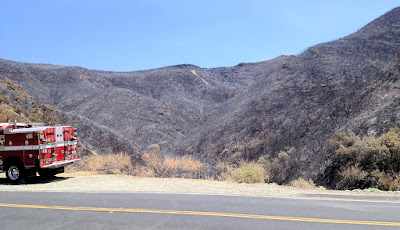 |
| View from our orchard as a fire rages 5 miles north of our property |
Our property was never in danger since we expect fires and prepare accordingly, keeping our ground closely mowed and clear of debris, trimming trees up away from the ground, and mowing wide barriers on adjacent properties if the owners don't. And we make sure to keep large hoses and full-flow valves in key spots around our property and buildings.
The first evening of the fire I took the time lapse video below from our porch. This really shows a fire with a life of its own.
Amazingly no homes were destroyed in these local fires, only a couple of outbuildings. This is a true testament to the expertise and hard work of firefighters. But though homes escaped it is always painful to see the damage to native vegetation. Huge areas of oak and pine woodlands have been incinerated, and as we've seen in past years, Manzanita and other low growing brush tends to then take over, leaving the hills even more prone to future fires.
 |
| A canyon near the start of the "Wragg fire" is left completely barren |
 |
| Scorched trees - some will survive, many will not |
My fireman neighbor described watching the air drops from a ridge top while listening to the fire fighters' radio channel. A small spotter plane flew along the advancing fire line, in radio communication with the bomber pilots and dropping white powder markers to indicate where the retardant drop should start and end, and recommending the rate of drop and warning of air turbulence and other dangers. Meanwhile the bombers would circle the area getting in position for the drop. When all was ready the spotter pilot would radio, "OK follow me" and lead the bomber along the drop path.
 |
| An air tanker drops retardant along a fire line |
 |
 |
 |
| A helicopter dips water from lake Berryessa to drop on a hot spot |
And not to give all the credit to the air drops, the hard working and dedicated ground crews are equally impressive. Bushwacking up steep hills in 100 degree+ heat wearing protective gear and carrying heavy equipment, often through heavy brush, these "boots on the ground" do incredibly hard work. They labor to hand-cut breaks to contain fires and to save structures.
So what are the lessons here? First, fires are a fact of life in California's dry areas, so we should expect them. Second, we are lucky to have such skilled and dedicated firefighters. But here's the thing I just don't get: Why do so many rural property owners fail to take basic steps to protect their properties from fire?
Why leave thick bushes, low hanging trees and tall dry grass around buildings? Sure firefighters are tasked with stopping fires, but why make their job tougher rather than easier? Why expose them to more personal danger than they are already in? Why not secure one's own property so when the inevitable fire approaches, the firefighters can put more manpower into stopping it from growing and threatening others' property? When seconds count, firefighters are minutes away, so why not give yourself every advantage? I just don't get it. End of rant, thanks for reading.
-Bill
So what are the lessons here? First, fires are a fact of life in California's dry areas, so we should expect them. Second, we are lucky to have such skilled and dedicated firefighters. But here's the thing I just don't get: Why do so many rural property owners fail to take basic steps to protect their properties from fire?
 |
| This house is practically asking to burn up in a grass fire, an all too common sight |
-Bill
